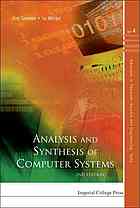(Ebook) Analysis and Synthesis of Computer Systems by Erol Gelenbe, Isi Mitrani ISBN 9781848163966, 1848163967
Analysis and Synthesis of Computer Systems presents a broad overview of methods that are used to evaluate the performance of computer systems and networks, manufacturing systems, and interconnected services systems. Aside from a highly readable style that rigorously addresses all subjects, this second edition includes new chapters on numerical methods for queueing models and on G-networks, the latter being a new area of queuing theory that one of the authors has pioneered. This book will have a broad appeal to students, practitioners and researchers in several different areas, including practicing computer engineers as well as computer science and engineering students. Read more...
1. Basic tools of probabilistic modelling. 1.1. General background. 1.2. Markov processes. The exponential distribution. 1.3. Poisson arrival streams. Important properties. 1.4. Steady-state. Balance diagrams. The "Birth and Death" process. 1.5. The M/M/1, M/M/c and related queueing systems. 1.6. Little's result. Applications. The M/G/1 system. 1. 7. Operational identities. 1.8. Priority queueing --
2. The queue with server of walking type and its applications to computer system modelling. 2.1. Introduction. 2.2. The queue with server of walking type with Poisson arrivals, and the M/G/1 queue. 2.3. Evaluation of secondary memory device performance. 2.4. Analysis of multiplexed data communication systems --
3. Queueing network models. 3.1. General remarks. 3.2. Feedforward networks and product-form solution. 3.3. Jackson networks. 3.4. Other scheduling strategies and service time distributions. 3.5. The BCMP theorem. 3.6. The computation of performance measures --
4. Queueing networks with multiple classes of positive and negative customers and product form solution. 4.1. Introduction. 4.2. The model. 4.3. Main results. 4.4. Existence of the solution to the traffic equations. 4.5. Conclusion --
5. Markov-modulated queues. 5.1. A multiserver queue with breakdowns and repairs. 5.2. Manufacturing blocking. 5.3. Phase-type distributions. 5.4. Checkpointing and recovery in the presence of faults. 5.5. Spectral expansion solution. 5.6. Balance equations. 5.7. Batch arrivals and/or departures. 5.8. A simple approximation. 5.9. The heavy traffic limit. 5.10. Applications and comparisons. 5.11. Remarks --
6. Diffusion approximation methods for general queueing networks. 6.1. Introduction. 6.2. Diffusion approximation for a single queue. 6.3. Diffusion approximations for general networks of queues with one customer class. 6.4. Approximate behaviour of a single queue in a network with multiple customer classes. 6.5. Conclusion --
7. Approximate decomposition and iterative techniques for closed model solution. 7.1. Introduction. 7.2. Subsystem isolation. 7.3. Decomposition as an approximate solution method. 7.4. An electric circuit analogy for queueing network solution --
8. Synthesis problems in single-resource systems : characterisation and control of achievable performance. 8.1. Problem formulation. 8.2. Conservation laws and inequalities. 8.3. Characterisation theorems. 8.4. The realisation of pre-specified performance vectors. Complete families of scheduling strategies. 8.5. Optimal scheduling strategies --
9. Control of performance in multiple-resource systems. 9.1. Some problems arising in multiprogrammed computer systems. 9.2. The modelling of system resources and program behaviour. 9.3. Control of the degree of multiprogramming. 9.4. The page fault rate control policy (RCP). 9.5. Control of performance by selective memory allocation. 9.6. Towards a characterisation of achievable performance in terminal systems --
10. A queue with server of walking type. 10.1. Introduction. 10.2. Properties of the waiting time process. 10.3. Application to a paging drum model.
*Free conversion of into popular formats such as PDF, DOCX, DOC, AZW, EPUB, and MOBI after payment.


